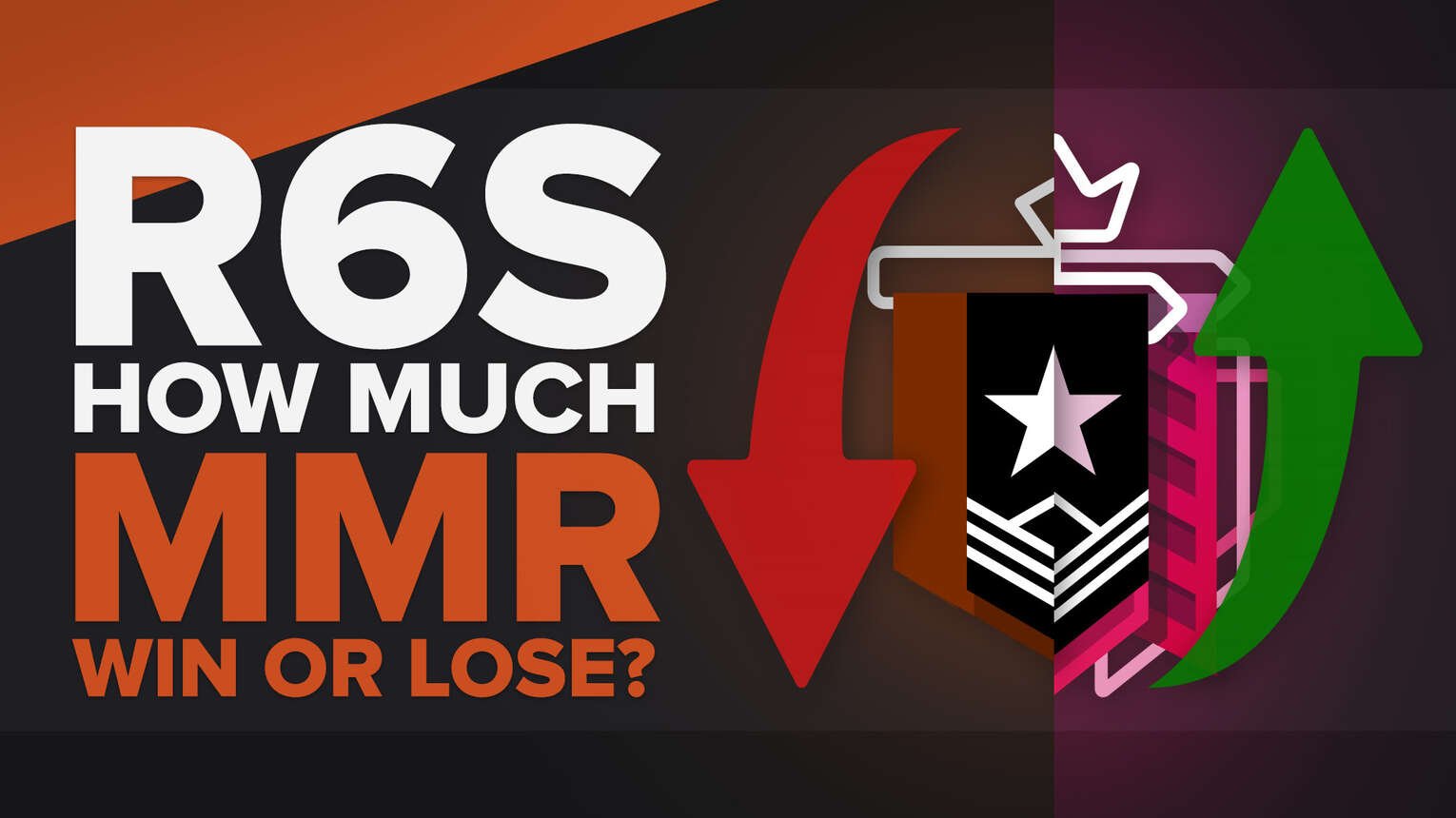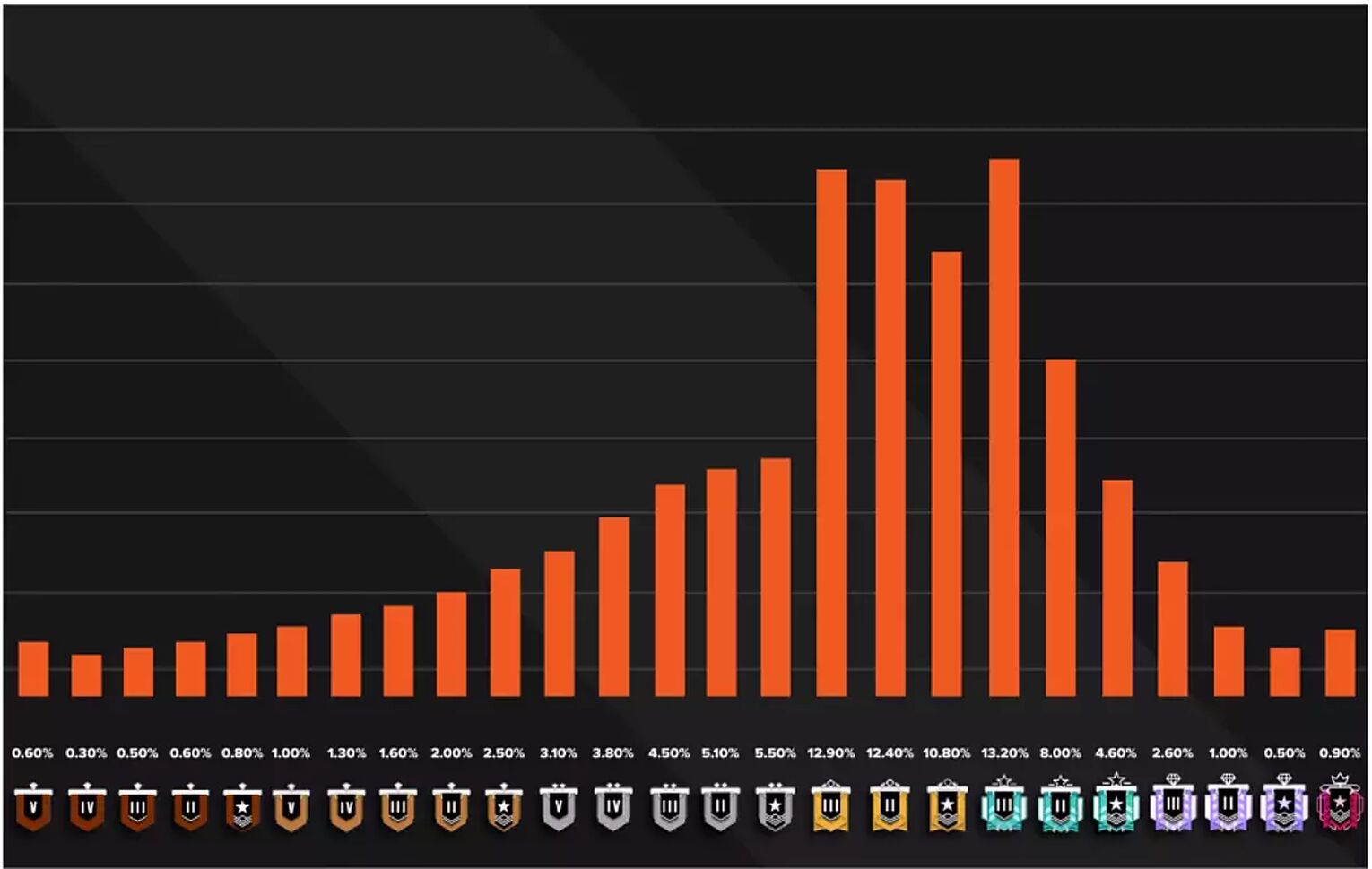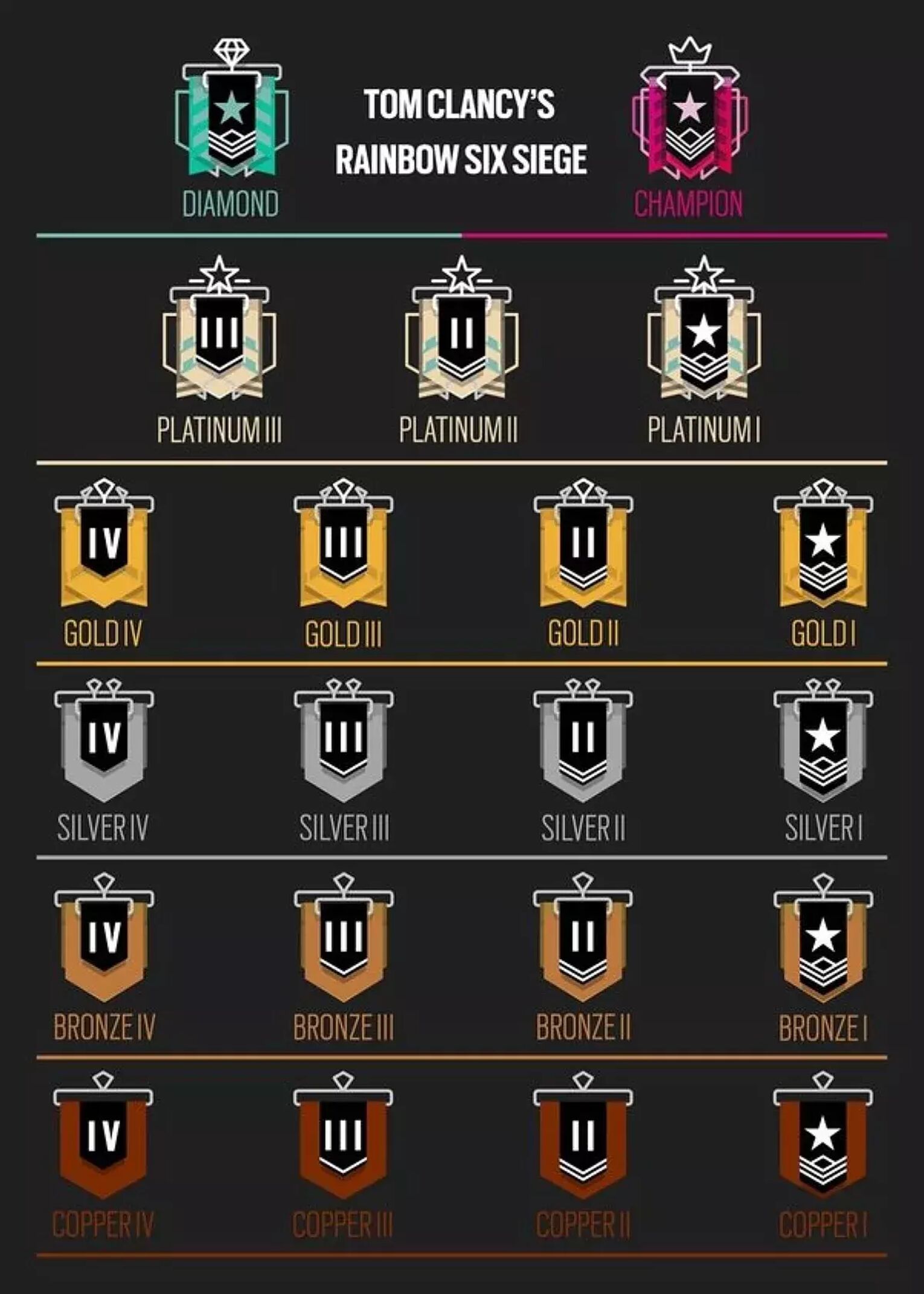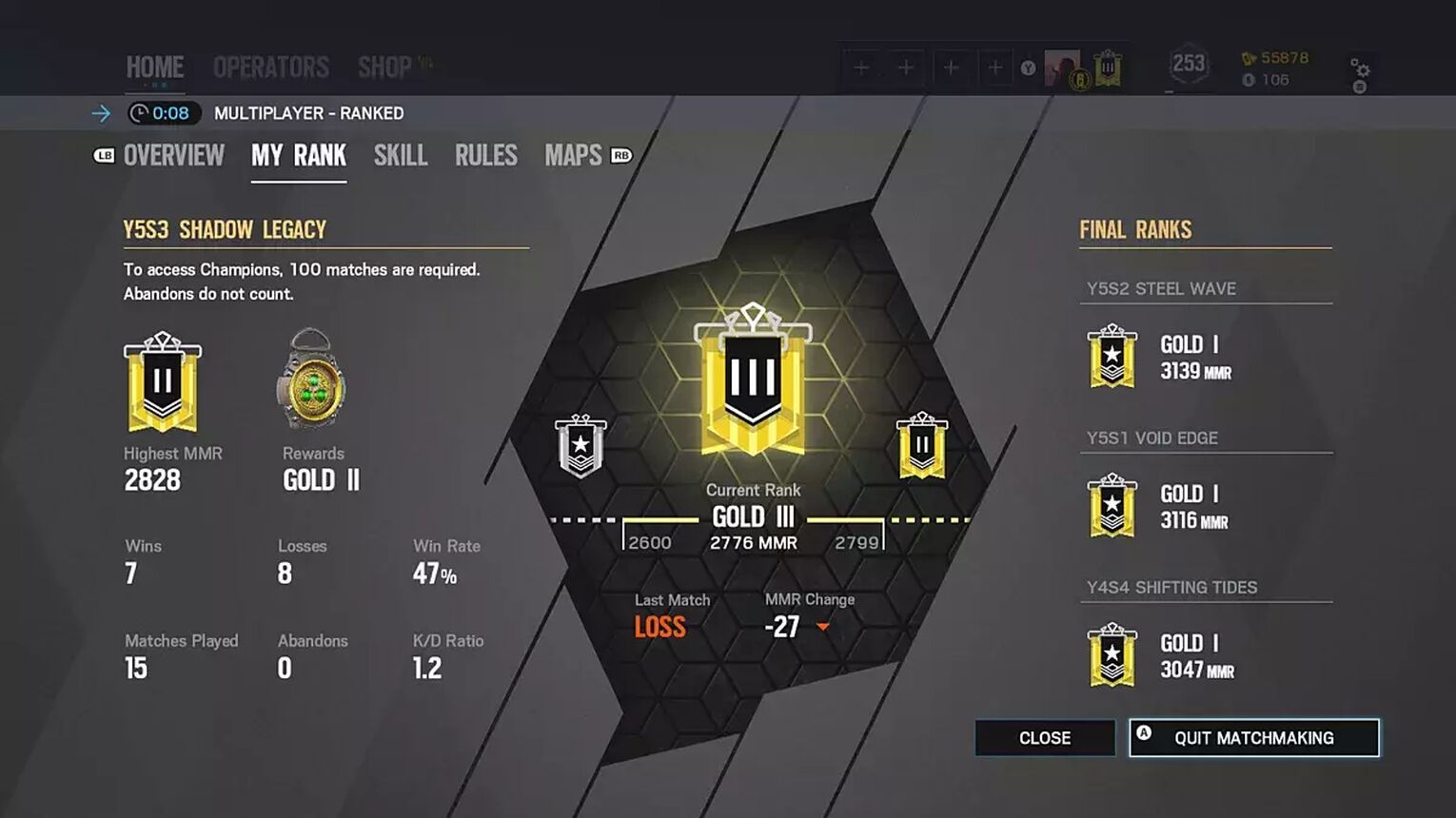
Let’s be honest. We’ve all experienced the frustration that follows after you’ve hard carried a stressful game of Ranked, yet still somehow gained a lesser rating than your teammates. Well, to save you from buying a new controller, mouse, or monitor every time that happens, we’ve designed an in-depth guide to help you understand how the MMR system works.

What is MMR in Siege and How Does it Work?
At the core of it, MMR is a straightforward ranking system - every competitive ranked game requires a metric in order to match people fairly. In Siege, this matric comes in the form of Matchmaking Rank, or MMR for short. The people who win the match gain MMR from the people who lose the match. However, every game doesn’t necessarily carry this one-to-one relationship, and Siege’s Ranked system has its own intricacies.
Like most competitive games, you will be placed somewhere on the Siege ranking distribution after a series of ‘placement games’ at the start of every ranked Season. After this, the way your MMR changes varies from game to game.
How Does Your MMR Change for Every Win or Loss in Siege?
The MMR gained or lost isn’t fixed for every game. You can expect to gain or lose an average amount of around 25 to 50 MMR. Different factors play into the amount of MMR you’ll gain for each result, such as
Skill differences between teams. If you beat a team with a higher average rank than you, you will gain more MMR. On the other end of the spectrum, you’d also lose more MMR as a result of losing against a lower-skilled opponent. Each win or loss can be interpreted as a measure of whether you belong in a certain rank: beat a Diamond as a Gold? The game pushes you faster towards Diamond and pulls the loser closer towards Gold.
Number of games played. At the beginning of the season, or when you play the first few games of Ranked, your MMR can be very volatile. Each game causes significant changes to your MMR until your win rate gets close to 50%. At that point, your MMR accurately represents your current skill level.
Sometimes you might feel that you’ve got the short end of the stick while your teammates get an unfairly high amount of MMR. Well, now you know what to blame and also what to focus on when playing the game: getting that dub. Just kidding - as long as you’re having fun playing the game, you’re good to go.

How to Check Your MMR After a Rainbow Six Siege Game?
After each game, you also see how much MMR you’ve gained or lost. This will give you an idea of how tough the lobby was compared to your rank.
There are two kinds of MMR you’ll come across in Siege. One will apply for your Quick and Unranked matches and remain hidden from everyone in-game. However, certain third-party trackers allow you to check your Unranked MMR. But let’s be honest, who really cares about their Unranked rating?
If we’re talking about the rank that actually matters, you can view your Ranked rating by double pressing your user icon twice while in the main menu. This will display your rank alongside how much rating you’re currently at.

Rainbow Six: Siege Rank Cutoffs
Now that you get the general gist of how MMR works in Siege, let’s hop on to the MMR cutoffs you need to break past to rank up. Take a look at the table below to see just how much more you need to climb to get to that sweet Champion badge beside your name.
Rank | MMR |
Copper V | < 1100 |
Copper | 1100 - 1600 |
Bronze | 1600 - 2100 |
Silver | 2100 - 2600 |
Gold | 2600 - 3200 |
Platinum | 3200 - 4100 |
Diamond | 4400 - 5000 |
Champion | > 5000 |
If you pay attention to the ranges for each rank cut-off, they seem pretty even across all ranks other than Platinum. However, the in-game grind can feel daunting for two reasons. The lower ranks (Copper, Bronze, and Silver) have five subdivisions, while the upper ranks (Gold, Platinum, and Diamond) have three subdivisions. This makes progress feel incredibly slow since the ELO gaps for each rank-up are more significant, while the games also get progressively challenging to win.

The most recent ranking distribution also echoes the same concept. The average player falls right under the early Gold divisions. You can also get a general idea of how tough it is to climb to the higher ranks, considering how small the player distribution gets in the upper echelons of the distribution.
Don’t let that stop you from playing the game, though. As we said before, the point of the game is to have fun. If you enjoy grinding through the ranks and have a flair for competition, keep improving your skills and trying your best. And if the process gets too tiring, you can always try the variety of game modes Siege has to offer!
Tips to Increase MMR Gain per Win
If the difficulty of the Ranked grind does not deter you, there are a couple of things you should focus on in order to boost your MMR
Always remember to warm up before your games. While you might be tempted to log on to Siege and immediately hop into a Ranked match, spending a few minutes in Deathmatch is never a bad idea to refresh that muscle memory.
Take necessary breaks. Siege games can be pretty quick, and it’s easy to feel you should queue to grab a win to balance out that tilting loss. Well, go easy on yourself. Your mental exhaustion will make you play way worse compared to how you’d play after taking a well-needed break.
Finally, know your Operators. It’s never a good idea to try out a brand new Operator in a game of Ranked. For that, you’ve got your Unranked and Quick Play playlists. Find out whether a particular Operator suits your playstyle, test them on different maps, and only then try them out in Ranked.


.svg)


![Best Esports Betting Sites With Crypto [With Bonus Codes]](https://theglobalgaming.com/assets/images/_generated/thumbnails/741131/best-esports-betting-sites-with-crypto-gaming_03b5a9d7fb07984fa16e839d57c21b54.jpeg)
![Rainbow Six: Siege Rank Distribution in 2024 [Visualized]](https://theglobalgaming.com/assets/images/_generated/thumbnails/649167/ranking-distribution-percentile-rainbow-six-siege-gaming_03b5a9d7fb07984fa16e839d57c21b54.jpeg)
![How To Uninstall Rainbow Six: Siege on your PC [All Ways]](https://theglobalgaming.com/assets/images/_generated/thumbnails/64361/62e9681d7583038ff84a0e42_how20to20uninstall20rainbow20six20siege_03b5a9d7fb07984fa16e839d57c21b54.jpeg)
